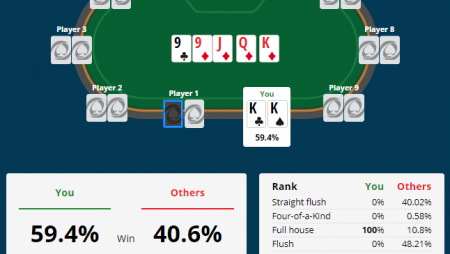

Learning Poker Odds and Pot Odds
This poker odd guide will work great for you if you know some basics about the game but have trouble understanding the odds of Texas Hold’em. This article will state some methods that will help you calculate pot and poker odds. Calculate your odds and win from your friends.
Poker odds can be quite confusing at the beginning. However, if you are a passionate player, then you must have basic information about poker odds. This article provides a short guide with the required tools to excel in online and live games.

Pot Odds Chart

For understanding the poker odds, you should have the odds chart. It is recommended to download and print the chart for Texas Hold’em. Keep the chart with yourself during the play for easy calculation of odds. Moreover, we also recommend learning about starting hands for better understanding.
| Bet Size (Pot Bet) | Example | Offered Pot Odds | Required Equity |
| 1/2 | $1 into $2 pot | 3:1 | 1/4 (25%) |
| 2/3 | $2 into $3 pot | 5:2 | 2/7 (29%) |
| 3/4 | $3 into $4 pot | 7:3 | 3/10 (30%) |
| Equals to Pot Size | $4 into $4 pot | 8:4 (2:1) | 4/12 or 1/3 (33%) |
| 2x | $8 into $4 pot | 12:8 (3:2) | 8/20 or 2/5 (40%) |
How Odds Work and the Long Shot
To make things easier to understand, let’s take the example of a horse race.
While betting during a horse race, if the odds are six to one, i.e., 6:1, it indicates that for every $1, you must pay $6.
That’s why if you are paying $10, you have the chance to win $60.
In situations where winning odds are higher than winning, the subsequent odd is called a long shot. That’s means that the chances to win the bet are lower. For example, if the odds are 100:1, you have almost no chance of winning.
Poker Odds Shows the Probability of Winning Hand
Before learning how to calculate poker odds, it is important to calculate outs. But what are outs? Outs refer to the cards that can be used for improving the poker hands. So, with outs, you can make your odds better and win over your opponent.
For calculating odds, you should first know your outs (winning cards). For better understanding, let’s assume there are four spades on the table. It means you are left with 9 spades now. These are the outs.
Calculating Texas Hold’em Odds using Outs
Players normally have nine outs, as determined in the section above. A player has a total of 52 cards in the deck. After he gets two, 50 cards are left in the deck. Moreover, four more cards are exposed on the table that leaves a total of 46 cards. The opponent also holds two cards but for our understanding, let’s ignore that.
Out of the remaining 46 unknown cards, the 9 are outs. With these 9 cards, you can win the hand. However, the probability of losing is pretty high since you have 37 cards with the chances to lose. That’s the odds become 37:9 or almost 4:1. This indicates that you have four times more chances to lose than win.
The Big Question: Should You Call the Bet?
The odds of winning the hand are around 4:1. The decision to whether call the bet is quite challenging. However, knowing how much money the pot holds can make your decision a bit easier. It does not mean that if the pot holds more cash, you bet. Use the money in the pot for calculating the ratio and comparing your opponent’s bet.
Continuing the same example stated above, let’s assume the pot holds around $90 and the opponent bets for $10. This makes the total of $100 for the winner to win. For seeing the river card, you should at least match the bet of your opponent. That means for checking your luck on the remaining 9 cards; you have to invest $10.
But What If I Lose?
In the above example, even if you call the bet, your win is still not guaranteed. This happens the majority of the time. The odds you calculated in the above example were 4:1, which means you had four times more chances to lose than win. However, these odds will reach breakeven in the long run.
A Handy Shortcut to the Rules

The rules might be a lot to process. It has both theory and math. However, with an easy shortcut provided in this section, we can easily get an understanding.
- Calculate the total number of outs (winning cards) on the deck after the flop. In the example above, the outs were 9.
- Calculate the chances of dealing a winning card on the river. This can be done by multiplying the outs by four. In our example, the value becomes 36%.
- After the fourth card is dealt, get the winning chance on the river. To get this, multiply the outs by 2. In the above example, the value is 18%.
This method might not be extremely precise, but you can easily get your odds calculated with the help of a cheat sheet.
Common Poker Hand Odds

We have assumed that the player is on the turn and wants a river instead of incorporating two cards to come for our calculations. For better understanding, let’s assume the cards you hold are 8♣ & 7♦ , and the cards on board are 2♠, 6♣, 9♦, and A♥.
Open-Ended Straight Draws: 4.8:1
Continuing the same example above, the total outs you have are 8, i.e., four tens and four fives. The hand odds here presume the board has no possible flush, and the player draws on the best possible hand. However, if the board has K♦, 2♦, 8♥, and 4♦ while you have A♣ and 10♠, then the 10s are no longer the outs for you.
Four to a Flush: 4.1:1
For this, let’s assume you have suited hole cards while two of the four cards on the board are also suited. This scenario is extremely rare as the chances of such happenings are low. However, in such scenarios, you should be careful because you might be in trouble if you lack the ace.
Inside Straight (Belly Buster): 10.5:1
For this example, let’s again assume that you chose to draw nuts. For instance, the board has A,9,5, and K, and you have 8,7. You will have the nuts if you get any of the sixes from the remaining cards. However, if you use both cards for making straight, you will lose the nuts. Moreover, if you have 2,7, and the board is 5,6,9 and A, getting 8 will provide a straight. However, this won’t be a nut straight. If another payer has 7 and T, he will have the nuts.
One Pair, Drawing to Two Pair to Trips: 8.2:1
If a player has J and T on the board with 3, 8, J, and A, then there are high chances that the against the party has a pair of aces. So, you have five outs here for beating him, i.e., two jacks and three tens. However, for these odds, we assume that the opponent does not have A, T, or A, J. in reality, a player should have more than 8:1 odds for increasing the winning chances.
Overcards on a Ragged Board on the Turn: 6.7:1
This is an extremely dangerous assumption. If a player has K and Q on the board with J, 2, 5, and 8 while your analysis says that your opponent has a pair of eight. Without Q and K kicker, your outs are six. Here, the odds of 6.7:1 are true if you have made the right assumption. However, the chances of making wrong assumptions are quite high here. So, be careful.
Drawing to a Set: 22:1
If the board has 2, 9, K, and A while you have a pair of sevens, you just need another 7. However, this draw is extremely far-fetched.
Drawing to X Outs: (46-X)/ X:1
This generic formula can be used for calculating odds other than the ones mentioned above. For this, the player has to calculate the total outs. Afterward, subtract the number of outs from 46 and then divide the total outs’ resulted number. You will get your odds.
For better understanding, let’s take this example. A player draws both to flush and set, and after proper analysis, he assumes that the opponent has two pairs. The cards the player has are a pair of A and four to flush. The outs here become any ace with a total of 9 flush cards. The total number of outs for the player in this scenario becomes 11. The total odds now become 3.2:1.
You can use an odds calculator and cheat sheets; these tools are vital while reviewing and studying poker hands.
Poker Odds FAQs
How to calculate odds in poker?
There are many helpful methods for calculating poker odds. Players normally carry cheat sheets for the purpose or just memorize different odds from the sheet. For instance, a small pair if the opponent has a big pair, the odds become 4/1.
If you want to calculate the odds yourself, you will need both time and effort. That’s why we recommend you use an odds calculator.
How to calculate odds quickly in my head?
For quickly calculating rough odds in your head, you should know the four and two rules. This rule has a simple process. First, calculate the outs and then multiply the total outs with two and then add two. Moreover, to make a flush on the river, multiply the total outs by four and add four.
How to calculate pre-flop poker odds?
We suggest using an odds calculator for this purpose. However, this trick might help in the easy calculation:
- 50/50 for pocket pair and two overcards.
- 4/1 underdog for small pair against big.
- 60/40 for two high and two low cards.
- 3/1 underdog for dominated hand.
What is pot equity?
Pot equity means the chance of winning shown in percentage. This can be estimated at any stage during the game.
What are pot odds?
By pot odds, we mean the price needed to call the bet relative to the pot size. Working on pot odds is quite tricky sometimes.
How to calculate pot odds?
For calculating pot odds, you should know your outs first. The easiest and simplest way to calculate pot odds is to use the 2 and 4 rule. As per the rule, if a player has two cards coming, then the odd can be calculated by multiplying the outs by four. Moreover, if a player has one more card to come, multiply the outs with two to get an estimated percentage.
What are good odds?
By good odds, we mean that the odds required for calling are better than the odds needed for making the hands.
What are the odds of flopping a set?
If the player has a pair of pockets, he will need to flop the set for a single time in nine.
What are the odds of flopping a flush?
For a player who has two suited cards, a flush can be flopped roughly for once in 118. However, a flush draw can flop for one in 10 times.
What are the odds of being dealt with pocket aces?
The chance of getting pocket aces is 1 in 220 hands.
What are the odds of winning a poker game?
For estimating winning odds in poker, a player should know the common hand odds in poker. These are 4.8:1 for open-ended straight draws, 4.1:1 for four to a flush, 10.5:1 for inside straight, 8.2:1 for a pair that draws to two or trips, 6.7:1 for overcards, and 22:1 for a set. The formula for specific odds calculation is (46-X)/X:1.
How do odds change with more players?
Higher the number of players lower the chances to win the pot. This is because if the pot has a higher number of players, the chances of them holding your outs increase that ultimately reduces your winning odds.
What are the numbers of possible hands in Texas Hold’em?
Texas Hold’em has a total of 169 starting hands with no distinction between suits. The best is two A while the worst are 3 and 2 or 7 and 2 unsuited. However, with the distinction between suits, the combination becomes 1326.
What is meant by outs?
Outs refer to the number of winning cards.
How to count outs?
For understanding the calculation of outs, let’s take an example. If a player has four hearts and is looking to win a flush, then there will be a total of nine hearts left (13-4=9). These 9 cards will be your winning cards.
What are the chances to win with pocket aces?
Pocket aces give good winning chances to the players. However, the winning odds are dependent upon the number of players on the pot. The normal practice shows an estimation of 25% if each player chooses to stay till the end.
What is the percentage to hit a set on the flop?
Estimation shows the value of 12% to hit a set on the flop.








